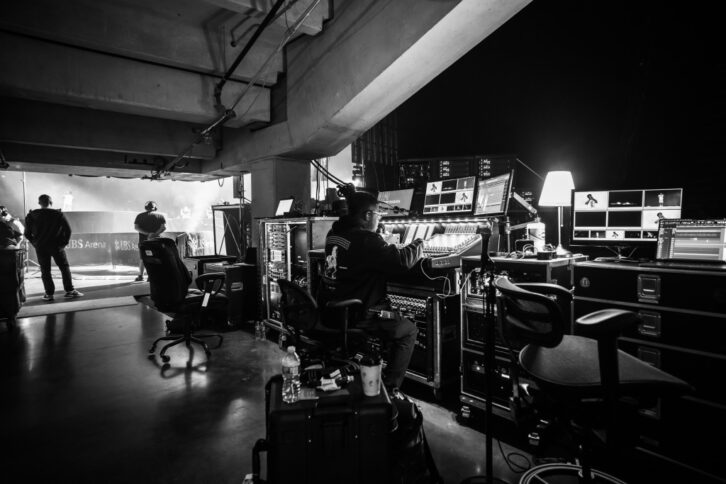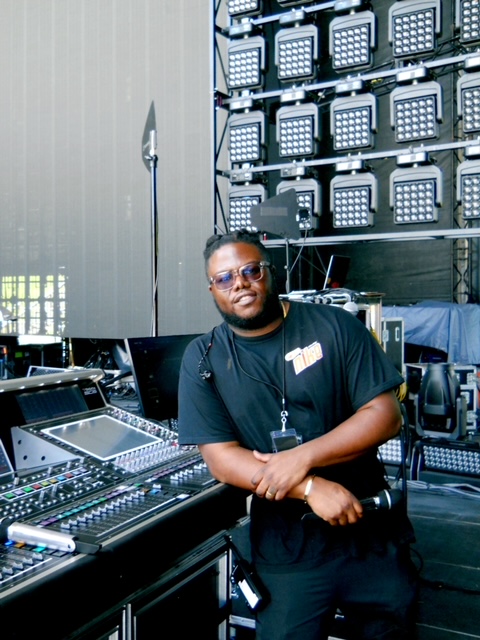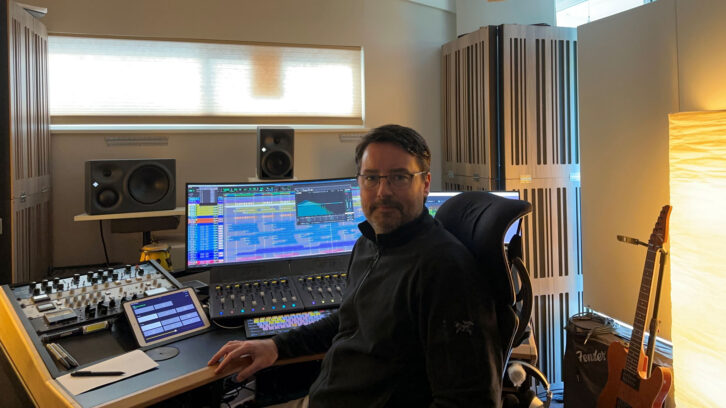
Like most artists sidelined by the pandemic, rapper/singer Post Malone was greater than able to hit the street final yr when his long-awaited fourth album, Twelve Carat Toothache, got here out in June. The globetrotting Twelve Carat Tour kicked off in September and now at every cease, engineer Travon Snipes may be present in Monitorworld, conserving mixes clear within the ears.
Snipes first tackled Malone’s monitor mixes in 2019, becoming a member of the manufacturing partway by means of the Runaway Tour’s Australian leg. Despite the manufacturing ending 5 reveals early in March, 2020 resulting from COVID tour suspensions, every little thing else went easily, and one worldwide pandemic later, Snipes headed again out with Malone’s 2022-23 tour, utilizing audio gear supplied by PRG. In addition to the thrill of returning to the street after a lot time, the brand new manufacturing meant Snipes lastly had a chance to construct a brand new monitor setup: “It was a brand new tour and for me, it was like a inexperienced mild to place my spin on learn how to do it, as a result of we have been all ranging from scratch—new music, new stage design, new P.A. I had a gap to place collectively my interpretation of what I assumed would work greatest for his sound.”
Grammy-Nominated Engineer Louis Bell Breaks Out
While it was an opportunity to include a few of his favourite gear and workflows into the monitor methodology, Snipes stayed targeted on making certain it was all there to help the artist onstage.
“I used to be tailoring this for an extremely gifted artist/singer who has a dynamic vary the place he may yell or sing or scream at completely different occasions—and thru all of it, it wanted to be a rounded sound that would transfer with him,” Snipes recalled. “Honestly, we hit the nail on the top fairly early; there wasn’t quite a lot of swapping gear out and in. We had one present the place I made the swap on his channel strip and microphone, and from that time on, he instantly was, ‘Man, one thing’s completely different. Whatever’s happening, I adore it.’ Ever since then, it has been golden.”
Determining the best vocal mic took some consideration, and in the end the manufacturing went with an uncommon mixture—a Sennheiser SKM 9000 transmitter and SKM 6000 receiver. “We journey a lot, and the 9000 receiver is sort of a tank, so we use the 6000 receivers,” mentioned Snipes. “I observed that the 9000 transmitter gave us extra physique and readability, so we opted to make use of the 9000 stick to the 9235 capsule, as a result of we would have liked that top rejection. We’re at all times both in entrance of a P.A. or the stage design has a runway for Post to stroll out on—if he sees that, he’s going to be on the market just about the entire efficiency! The capsule can deal with his dynamic vary; it received’t crumble or give out. Also, he’ll be singing and the mic can be laying on the bottom, or typically he’ll have it standing up on the antenna—he does some issues I’ve by no means seen achieved earlier than—so we would have liked a mic that would stand up to that and be dependable. He’s complemented it, like ‘Man, this mic sounds so unimaginable.’”
Also serving to hold the mic bleed minimized is a artful P.A. design for the tour’s 192 L-Acoustics loudspeakers—eight equivalent hangs of 16 K2 enclosures; 4 cardioid-configured hangs of eight KS28 subs plus eight extra KS28 on the sector flooring; and 4 hangs of six Karas, horizontally flown as viewers pit-fills. FOH engineer Burton Ishmael, Dave Brooks at L-Acoustics, Posty Touring’s Production Manager Dennis Danneels and PRG’s Burton Tenenbein devised a design supposed to maintain power on the runways down a minimal of 15 dB, serving to put much less extraneous audio into Malone’s mic.
That vocal microphone is likely one of the few dwell inputs that Snipes has to work with on his DiGiCo Quantum 5 console; the one different main components are Malone’s acoustic guitar, captured by way of a Hazelrigg Industries VDI tube DI chosen for its heat, and 15 channels of playback tracks. Snipes takes care of these channels in addition to viewers mics and appreciable talkback exercise largely targeted on making certain the artist is nicely away from the copious quantities of pyro and flames used all through the present.

While some may anticipate a combination principally primarily based round playback tracks to be a comparatively easy job, Snipes defined that simply the alternative is true: “Lots of people can be like, ‘Oh man, you will have the simplest gig.’ No, when you will have much less to work with, you need to discover artistic methods to make it really feel large in his ears. It’s not a band up there the place there’s drums, guitars, keys and extra issues you may play with and use to fill it out. When you will have simply tracks, you may’t let it really feel weak on stage, so that you undoubtedly should get artistic to make it really feel full.”
Malone hears these mixes by means of in-ear screens, having moved to FIR Audio Xenon 6 earpieces and a Wisycom wi-fi pack for the present tour. Snipes first got here throughout the monitor model whereas researching IEM cleansing vacuums—FIR makes one—and earlier than lengthy, he requested for a demo of the corporate’s in-ears.
Shaping the mixes, Snipes has various Waves choices at his disposal, making use of the corporate’s Primary Source Expander plug-in to cut back stage bleed. Other plugs put to work embrace Waves NLS Buss, NLS Channel, an SSL EQ and the F6 floating-band dynamic EQ, which he singles out as a specific favourite: “That’s a workhorse for me, as a result of it permits me to essentially fine-tune the shaping of the vocal, which is essential. Each artist sounds completely different—they’ll use the identical mic, however tonally you need to form their voice to suit what’s happening, and F6 actually helps me do this.”
While many engineers deep-dive into plug-ins, Snipes tends to choose outboard gear, leaning closely into racked-up 500 Series items like a Burl Audio B1 mic pre; Empirical Labs EL-DS; Electrodyne 511 EQ; WesAudio Hyperion parametric EQ and Mimas FET compressor; Retro Instruments Doublewide II tube compressor; Serpent Send N’ Blend combine/ mix module; and a Rupert Neve Designs 542 tape emulator. While most of that’s utilized to the vocal chain, Burl Audio has one other presence in Monitorworld: “I’m utilizing a Burl Mothership for all my AD/DA conversion of the gear, due to the heat and the transformers on that factor. I can speak about Burl without end—that firm makes some unimaginable gear.

“Also, Maag Audio is one other firm the place I exploit quite a lot of their merchandise, just like the EQ4M. I used to be utilizing it initially on Post’s general combine, however I moved it over to the guitar for normal EQ and coloring, including extra heat and sonic readability to the sound. That piece is sort of a coloring field; you are able to do so many various issues with it, shaping and taking a sound to the following degree.”
Many of these items aren’t usually discovered on the street, as Snipes readily admitted, noting, “I’ve at all times gravitated to these smaller firms and that boutique sound; once I implement one thing, I don’t need to use every little thing that everybody else has. I discovered Hazelrigg Industries by means of a good friend of mine at Sweetwater, Mike Picotte [senior sales engineer and artist relations], who has been an incredible assist. In this business, you need to have an organization and an individual that you would be able to name and say, ‘Hey, I want this tomorrow,’ so shout out to Sweetwater and Mike for his or her help all through the years.”
In the meantime, Snipes himself continues to help Malone, because the Twelve Carat Tour simply began making its means by means of Europe—although it’s not as if the artist and audio staff took it simple because the U.S. leg resulted in November.
“We’ve been busy!” laughed Snipes. “We did the Middle East, had a month off, went to Australia, acquired again, had a day or two residence after which went to do NBA All-Star Weekend. It’s been wonderful—at all times glad to be working!”


